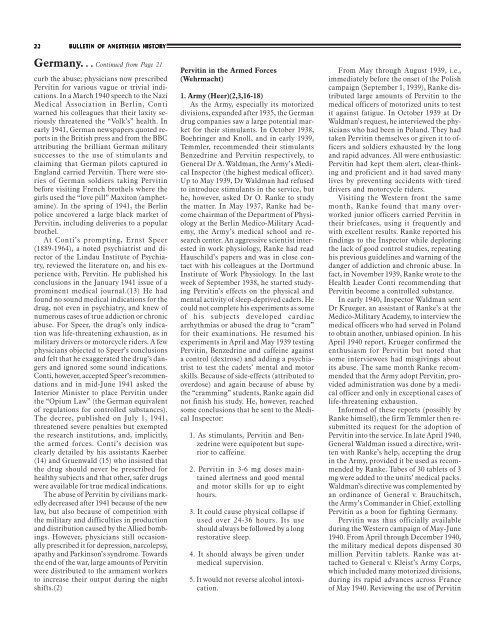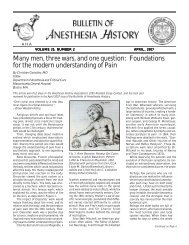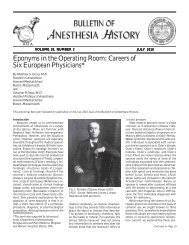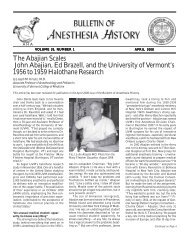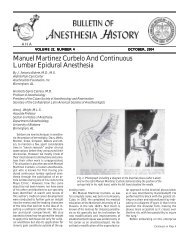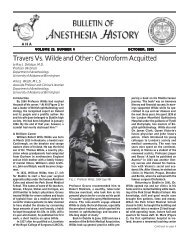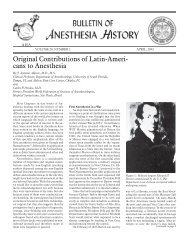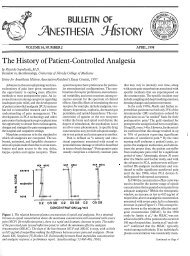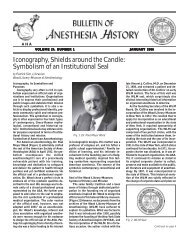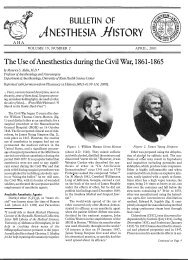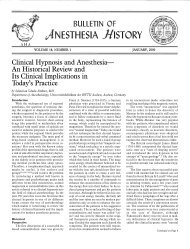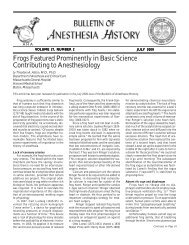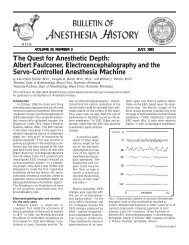April 2011 - Anesthesia History Association
April 2011 - Anesthesia History Association
April 2011 - Anesthesia History Association
You also want an ePaper? Increase the reach of your titles
YUMPU automatically turns print PDFs into web optimized ePapers that Google loves.
22 22<br />
BULLETIN BULLETIN OF OF ANESTHESIA ANESTHESIA HISTORY<br />
HISTORY<br />
Germany. .. Continued from Page 21<br />
curb the abuse; physicians now prescribed<br />
Pervitin for various vague or trivial indications.<br />
In a March 1940 speech to the Nazi<br />
Medical <strong>Association</strong> in Berlin, Conti<br />
warned his colleagues that their laxity seriously<br />
threatened the “Volk’s” health. In<br />
early 1941, German newspapers quoted reports<br />
in the British press and from the BBC<br />
attributing the brilliant German military<br />
successes to the use of stimulants and<br />
claiming that German pilots captured in<br />
England carried Pervitin. There were stories<br />
of German soldiers taking Pervitin<br />
before visiting French brothels where the<br />
girls used the “love pill” Maxiton (amphetamine).<br />
In the spring of 1941, the Berlin<br />
police uncovered a large black market of<br />
Pervitin, including deliveries to a popular<br />
brothel.<br />
At Conti’s prompting, Ernst Speer<br />
(1889-1964), a noted psychiatrist and director<br />
of the Lindau Institute of Psychiatry,<br />
reviewed the literature on, and his experience<br />
with, Pervitin. He published his<br />
conclusions in the January 1941 issue of a<br />
prominent medical journal.(13) He had<br />
found no sound medical indications for the<br />
drug, not even in psychiatry, and knew of<br />
numerous cases of true addiction or chronic<br />
abuse. For Speer, the drug’s only indication<br />
was life-threatening exhaustion, as in<br />
military drivers or motorcycle riders. A few<br />
physicians objected to Speer’s conclusions<br />
and felt that he exaggerated the drug’s dangers<br />
and ignored some sound indications.<br />
Conti, however, accepted Speer’s recommendations<br />
and in mid-June 1941 asked the<br />
Interior Minister to place Pervitin under<br />
the “Opium Law” (the German equivalent<br />
of regulations for controlled substances).<br />
The decree, published on July 1, 1941,<br />
threatened severe penalties but exempted<br />
the research institutions, and, implicitly,<br />
the armed forces. Conti’s decision was<br />
clearly detailed by his assistants Kaerber<br />
(14) and Gruenwald (15) who insisted that<br />
the drug should never be prescribed for<br />
healthy subjects and that other, safer drugs<br />
were available for true medical indications.<br />
The abuse of Pervitin by civilians markedly<br />
decreased after 1941 because of the new<br />
law, but also because of competition with<br />
the military and difficulties in production<br />
and distribution caused by the Allied bombings.<br />
However, physicians still occasionally<br />
prescribed it for depression, narcolepsy,<br />
apathy and Parkinson’s syndrome. Towards<br />
the end of the war, large amounts of Pervitin<br />
were distributed to the armament workers<br />
to increase their output during the night<br />
shifts.(2)<br />
Pervitin in the Armed Forces<br />
(Wehrmacht)<br />
1. Army (Heer)(2,3,16-18)<br />
As the Army, especially its motorized<br />
divisions, expanded after 1935, the German<br />
drug companies saw a large potential market<br />
for their stimulants. In October 1938,<br />
Boehringer and Knoll, and in early 1939,<br />
Temmler, recommended their stimulants<br />
Benzedrine and Pervitin respectively, to<br />
General Dr A. Waldman, the Army’s Medical<br />
Inspector (the highest medical officer).<br />
Up to May 1939, Dr Waldman had refused<br />
to introduce stimulants in the service, but<br />
he, however, asked Dr O. Ranke to study<br />
the matter. In May 1937, Ranke had become<br />
chairman of the Department of Physiology<br />
at the Berlin Medico-Military Academy,<br />
the Army’s medical school and research<br />
center. An aggressive scientist interested<br />
in work physiology, Ranke had read<br />
Hauschild’s papers and was in close contact<br />
with his colleagues at the Dortmund<br />
Institute of Work Physiology. In the last<br />
week of September 1938, he started studying<br />
Pervitin’s effects on the physical and<br />
mental activity of sleep-deprived cadets. He<br />
could not complete his experiments as some<br />
of his subjects developed cardiac<br />
arrhythmias or abused the drug to “cram”<br />
for their examinations. He resumed his<br />
experiments in <strong>April</strong> and May 1939 testing<br />
Pervitin, Benzedrine and caffeine against<br />
a control (dextrose) and adding a psychiatrist<br />
to test the cadets’ mental and motor<br />
skills. Because of side-effects (attributed to<br />
overdose) and again because of abuse by<br />
the “cramming” students, Ranke again did<br />
not finish his study. He, however, reached<br />
some conclusions that he sent to the Medical<br />
Inspector:<br />
1. As stimulants, Pervitin and Benzedrine<br />
were equipotent but superior<br />
to caffeine.<br />
2. Pervitin in 3-6 mg doses maintained<br />
alertness and good mental<br />
and motor skills for up to eight<br />
hours.<br />
3. It could cause physical collapse if<br />
used over 24-36 hours. Its use<br />
should always be followed by a long<br />
restorative sleep.<br />
4. It should always be given under<br />
medical supervision.<br />
5. It would not reverse alcohol intoxication.<br />
From May through August 1939, i.e.,<br />
immediately before the onset of the Polish<br />
campaign (September 1, 1939), Ranke distributed<br />
large amounts of Pervitin to the<br />
medical officers of motorized units to test<br />
it against fatigue. In October 1939 at Dr<br />
Waldman’s request, he interviewed the physicians<br />
who had been in Poland. They had<br />
taken Pervitin themselves or given it to officers<br />
and soldiers exhausted by the long<br />
and rapid advances. All were enthusiastic:<br />
Pervitin had kept them alert, clear-thinking<br />
and proficient and it had saved many<br />
lives by preventing accidents with tired<br />
drivers and motorcycle riders.<br />
Visiting the Western front the same<br />
month, Ranke found that many overworked<br />
junior officers carried Pervitin in<br />
their briefcases, using it frequently and<br />
with excellent results. Ranke reported his<br />
findings to the Inspector while deploring<br />
the lack of good control studies, repeating<br />
his previous guidelines and warning of the<br />
danger of addiction and chronic abuse. In<br />
fact, in November 1939, Ranke wrote to the<br />
Health Leader Conti recommending that<br />
Pervitin become a controlled substance.<br />
In early 1940, Inspector Waldman sent<br />
Dr Krueger, an assistant of Ranke’s at the<br />
Medico-Military Academy, to interview the<br />
medical officers who had served in Poland<br />
to obtain another, unbiased opinion. In his<br />
<strong>April</strong> 1940 report, Krueger confirmed the<br />
enthusiasm for Pervitin but noted that<br />
some interviewees had misgivings about<br />
its abuse. The same month Ranke recommended<br />
that the Army adopt Pervitin, provided<br />
administration was done by a medical<br />
officer and only in exceptional cases of<br />
life-threatening exhaustion.<br />
Informed of these reports (possibly by<br />
Ranke himself), the firm Temmler then resubmitted<br />
its request for the adoption of<br />
Pervitin into the service. In late <strong>April</strong> 1940,<br />
General Waldman issued a directive, written<br />
with Ranke’s help, accepting the drug<br />
in the Army, provided it be used as recommended<br />
by Ranke. Tubes of 30 tablets of 3<br />
mg were added to the units’ medical packs.<br />
Waldman’s directive was complemented by<br />
an ordinance of General v. Brauchitsch,<br />
the Army’s Commander in Chief, extolling<br />
Pervitin as a boon for fighting Germany.<br />
Pervitin was thus officially available<br />
during the Western campaign of May-June<br />
1940. From <strong>April</strong> through December 1940,<br />
the military medical depots dispensed 30<br />
million Pervitin tablets. Ranke was attached<br />
to General v. Kleist’s Army Corps,<br />
which included many motorized divisions,<br />
during its rapid advances across France<br />
of May 1940. Reviewing the use of Pervitin


